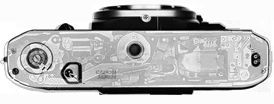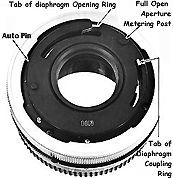AE-1's exposure
flow chart


Although looks complicating, but
the AE-1 has a very modular construction.
There are five main modules in 1) Viewfinder Unit, 2)
Shutter Unit, 3) Mirror Unit, 4)
AE Aperture Unit, 5) Automatic Diaphragm Unit
The key advantages of a modular construction are: streamline processing and assembly,
improved durability, better precision and most important of all, decreased cost of
production. But as earlier days of electronic cameras, most users regarded these
as 'unrepairable' components and differ from mechanical bodies which can look for
replacement of individual parts. Well, all modern electronic cameras are made this
way now, even the most hardcore users have accepted the fact...
The AE-1was designed from the ground up with five major units and twenty-five minor
units. They were centrally controlled by a microcomputer. The major advantage of
automation in the camera design and thus followed by manufacturing process is: by
incorporating electronics, the parts count in a camera will be greatly reduced as
compared with an mechanical camera, the AE-1, in this case, could be reduced by 300.
The manufacturing of the camera was also highly automated. This made it possible
to produce a low-cost camera having high-end features. The record sales of 5 million
units attributed by a combination of variable factors set by the AE-1 will be long
remembered and chances of breaking by another model is very slim.
Some technical info:
- You can lock the stop-down lever at the stopped-down position when you're set to a manual f/stop setting (Note: It can only be used at manual f stop settings). You can then use the FL lenses with stopped-down metering. Suppose that your diaphragm-setting ring is at "A" and you decide to use the depth-offield preview. You turn the diaphragm-setting ring to a manual setting and push in the stop-down lever. But before you return the diaphragm-setting ring to the "A" position, set the largest aperture. Otherwise, the camera won't program the aperture automatically.
- The backlight control button automatically opens up 1.5 f stop overexposure as compensation for backlighted subject.
- The self-timer function delays the shutter release for 10 seconds. During the selftimer operation, the self-timer LED flashes on and off twice a second (2 Hz).
- There are two warning LED's visible through the finder. If you're set to a manual f/stop, the LED at the top of the aperture scale flashes on and off as you start depressing the release button. The LED then illuminates the letter "M" for "manual. " A second LED at the bottom of the aperture scale flashes on and off to warn of underexposure. Both LED's flash at 4 Hz.
- When you push the battery-test
button, the needle should move to the battery-test mark or below it. The battery-test
mark also provides the stopped-down-metering mark when you're using the FL lenses.


- The front surface of the maximum-aperture correction pin should be 5.7mm (+0, - 0.2mm) from the front surface of the lens-mounting ring. To make the adjustment, first loosen the set screw in the center of the maximum-aperture correction pin. You can then turn the maximum-aperture correction pin clockwise to increase the distance. To decrease the distance, turn the rllaximum-aperture correction pin counterclockwise and turn in the setscrew to hold the adjustment.
 |
 |
- The flange-focal distance to 41.9mm
between the front of the lens-mounting ring and the film-guide rails or to 42.14mm
between the lens mounting ring and the pressure-plate rails.

| Back | The Index page of Canon AE-1
| Back | The Index page of Canon
AE-1
| Back |
Main Index Page of Canon SLR Models
Main Features & Background
Basic Camera Operation (7 Parts)
Auto Winder A | Winder A2 | Speedlites | Other Issues
Specifications: HTML | PDF (14K)
Main Reference map: HTML | PDF (213k)
| Message Board |
for your Canon
A-Series SLR camera(s)
| Message Board |
for your Canon optics in a shared environment
| Message Board |
Specifically for Dispose or Looking for Canon Photographic Equipment
Shared Resources:
Winder A, Winder A2, Focusing Screens, Motor Drive MA, Databack A,
Speedlites & Macro
photography.
Canon FD
Resources
Camera
Bodies:
A Series: AE-1
| AT-1
| A-1 | AV-1
| AE-1 Program | AL-1
T- Series: T50
| T60
| T70
| T80
| T90
F-1
| New F-1
Canon FL
Resources
Pellix
| FTQL
FL | Canon
FDn lenses.
| Early versions of FD lenses
Home - Photography in Malaysia |
Copyright © 2000. leofoo ®. MIR Web Development Team.
Maintenance Team: Kaipin, Terry Carraway & Dr Strangelove; Pawel Nabe for his image on the Data Memory Back. EEwyn Foo, my nephew, who has spent quite a number of nights converting the original manual in HTML format. Mr. Richard Yeow, General Manager -Optical Division of Canon Marketing for granting special permission to reproduce this manual into HTML format in his site as a form of obligation to all Canon FD mount users worldwide. * Canon, FD Lenses, Canon Marketing are registered trade names or trademarks of Canon Inc. Japan.